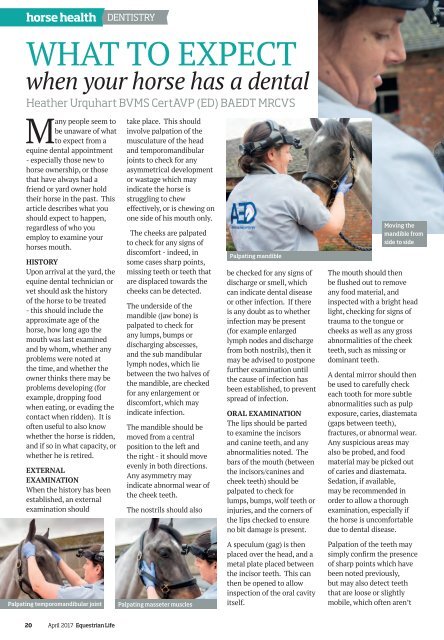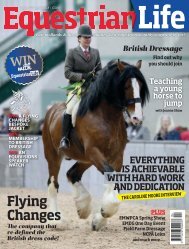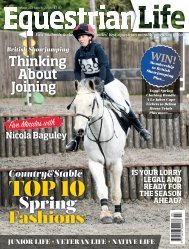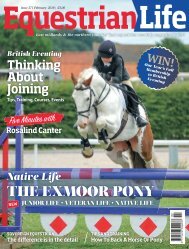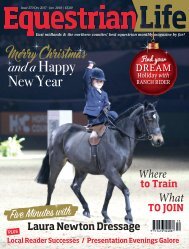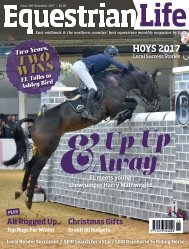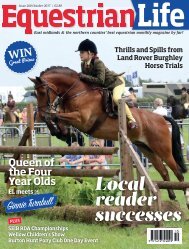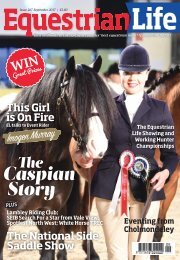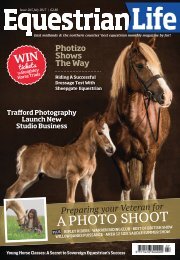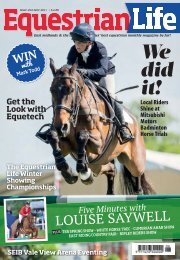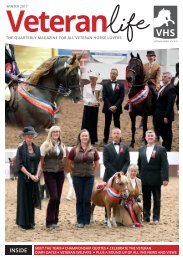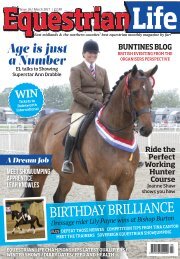Equestrian Life April 2017 Edition
The leading monthly magazine for the East Midlands and Northern Counties
The leading monthly magazine for the East Midlands and Northern Counties
Create successful ePaper yourself
Turn your PDF publications into a flip-book with our unique Google optimized e-Paper software.
horse health<br />
DENTISTRY<br />
WHAT TO EXPECT<br />
when your horse has a dental<br />
Heather Urquhart BVMS CertAVP (ED) BAEDT MRCVS<br />
Many people seem to<br />
be unaware of what<br />
to expect from a<br />
equine dental appointment<br />
- especially those new to<br />
horse ownership, or those<br />
that have always had a<br />
friend or yard owner hold<br />
their horse in the past. This<br />
article describes what you<br />
should expect to happen,<br />
regardless of who you<br />
employ to examine your<br />
horses mouth.<br />
HISTORY<br />
Upon arrival at the yard, the<br />
equine dental technician or<br />
vet should ask the history<br />
of the horse to be treated<br />
- this should include the<br />
approximate age of the<br />
horse, how long ago the<br />
mouth was last examined<br />
and by whom, whether any<br />
problems were noted at<br />
the time, and whether the<br />
owner thinks there may be<br />
problems developing (for<br />
example, dropping food<br />
when eating, or evading the<br />
contact when ridden). It is<br />
often useful to also know<br />
whether the horse is ridden,<br />
and if so in what capacity, or<br />
whether he is retired.<br />
EXTERNAL<br />
EXAMINATION<br />
When the history has been<br />
established, an external<br />
examination should<br />
take place. This should<br />
involve palpation of the<br />
musculature of the head<br />
and temporomandibular<br />
joints to check for any<br />
asymmetrical development<br />
or wastage which may<br />
indicate the horse is<br />
struggling to chew<br />
effectively, or is chewing on<br />
one side of his mouth only.<br />
The cheeks are palpated<br />
to check for any signs of<br />
discomfort - indeed, in<br />
some cases sharp points,<br />
missing teeth or teeth that<br />
are displaced towards the<br />
cheeks can be detected.<br />
The underside of the<br />
mandible (jaw bone) is<br />
palpated to check for<br />
any lumps, bumps or<br />
discharging abscesses,<br />
and the sub mandibular<br />
lymph nodes, which lie<br />
between the two halves of<br />
the mandible, are checked<br />
for any enlargement or<br />
discomfort, which may<br />
indicate infection.<br />
The mandible should be<br />
moved from a central<br />
position to the left and<br />
the right - it should move<br />
evenly in both directions.<br />
Any asymmetry may<br />
indicate abnormal wear of<br />
the cheek teeth.<br />
The nostrils should also<br />
Palpating mandible<br />
be checked for any signs of<br />
discharge or smell, which<br />
can indicate dental disease<br />
or other infection. If there<br />
is any doubt as to whether<br />
infection may be present<br />
(for example enlarged<br />
lymph nodes and discharge<br />
from both nostrils), then it<br />
may be advised to postpone<br />
further examination until<br />
the cause of infection has<br />
been established, to prevent<br />
spread of infection.<br />
ORAL EXAMINATION<br />
The lips should be parted<br />
to examine the incisors<br />
and canine teeth, and any<br />
abnormalities noted. The<br />
bars of the mouth (between<br />
the incisors/canines and<br />
cheek teeth) should be<br />
palpated to check for<br />
lumps, bumps, wolf teeth or<br />
injuries, and the corners of<br />
the lips checked to ensure<br />
no bit damage is present.<br />
Moving the<br />
mandible from<br />
side to side<br />
The mouth should then<br />
be flushed out to remove<br />
any food material, and<br />
inspected with a bright head<br />
light, checking for signs of<br />
trauma to the tongue or<br />
cheeks as well as any gross<br />
abnormalities of the cheek<br />
teeth, such as missing or<br />
dominant teeth.<br />
A dental mirror should then<br />
be used to carefully check<br />
each tooth for more subtle<br />
abnormalities such as pulp<br />
exposure, caries, diastemata<br />
(gaps between teeth),<br />
fractures, or abnormal wear.<br />
Any suspicious areas may<br />
also be probed, and food<br />
material may be picked out<br />
of caries and diastemata.<br />
Sedation, if available,<br />
may be recommended in<br />
order to allow a thorough<br />
examination, especially if<br />
the horse is uncomfortable<br />
due to dental disease.<br />
Palpating temporomandibular joint<br />
Palpating masseter muscles<br />
A speculum (gag) is then<br />
placed over the head, and a<br />
metal plate placed between<br />
the incisor teeth. This can<br />
then be opened to allow<br />
inspection of the oral cavity<br />
itself.<br />
Palpation of the teeth may<br />
simply confirm the presence<br />
of sharp points which have<br />
been noted previously,<br />
but may also detect teeth<br />
that are loose or slightly<br />
mobile, which often aren’t<br />
20 <strong>April</strong> <strong>2017</strong> <strong>Equestrian</strong> <strong>Life</strong>


